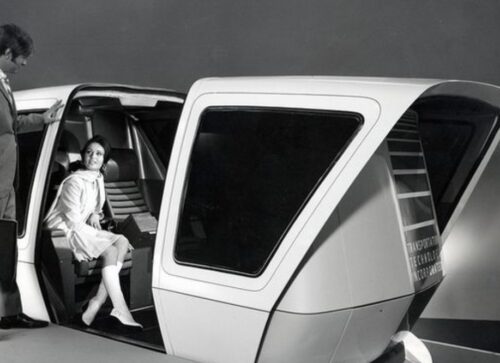This analysis examines how Tesla and its CEO employ Cold War-era propaganda techniques to potentially undermine American democratic institutions, viewed through the lens of Karl Popper’s paradox of tolerance. The evidence suggests concerning parallels between historical authoritarian technological messaging and current corporate practices that may pose significant national security risks.
Tesla’s deployment of technological theater—particularly in its Robovan and autonomous vehicle programs—bears striking similarities to Cold War-era psychological operations designed to project technological superiority. Consider the historical precedent of robotic transit technology projected by America during the Cold War:

The historical context is crucial. Silicon Valley emerged from Department of Defense initiatives, particularly following the devastating losses during operations like the 1943 Schweinfurt raid. Transportation systems became a key ideological battleground, as documented in Berlin’s tram network history:
When Berlin was divided, the tramway was also split in twain. The West side was managed by BVG-West and the East side by BVG-Ost, later renamed the VEB Kombinat Berliner Verkehrsbetriebe (BVB). The ideological differences between the two regimes were soon manifested on the tramway: before the city was split, women had been allowed to drive trams, albeit mostly during World War I and World War II during labor shortages. But in Fighting the Cold War in Post-Blockade, Pre-Wall Berlin, Mark Fenemore notes that women in West Berlin were banned from driving trams, as well as trains and buses, due to “medical rules.” As a result, authorities on the western side refused to allow a tram driven by a woman to cross into their sectors, and would “[make] the tram wait until a man replacement driver arrived.” In January 1953, large-scale prohibition of women tram drivers coming into West Berlin went into effect. As a result, one woman who was driving a tram was stopped at gun point and told to go back to the east.
This historical precedent of using transportation technology as an ideological battleground finds modern echoes in Tesla’s operations. Consider the 1959 RCA demonstrations, where technological promises served as anti-Soviet propaganda:

All of these electronic miracles are in existence. They are products of the David Sarnoff Research Center in Princeton, N. J., and scientists of the Radio Corporation of America are working today to make them available to you tomorrow. Let’s examine the automated house and its amazing Home Electronic Center, which consists of a miniaturized system of all-electronic mechanisms already lab-tested at Princeton. […] RCA engineers call this wonder system the Home Electronic Center Kid, or HECK. […] These are just some of the electronic miracles that you will live to see. They are in the labs today. They will be in your home tomorrow.
Parallels between this historical propaganda and Tesla’s current practices are alarming. Both use grandiose promises of future technology to manipulate public perception and potentially mask deeper political agendas. Moreover, the underlying misogyny present in a 1959 demonstration finds clear echoes in Tesla culture, where women are often marginalized or objectified by a CEO who repeatedly refers to them as “birthing” systems to replenish the white race (e.g. 1943 beheading of Sophie Scholl). This 1959 “Robovac” promotional video literally ends by saying women don’t want to work.
Tesla’s modern incarnation of this strategy is particularly evident in its Robovan concept:

The design’s striking similarity to historical authoritarian transport concepts raises serious security concerns, especially when viewed alongside Tesla’s pattern of unfulfilled technological promises. Since 2016, CEO Elon Musk has repeatedly promised coast-to-coast autonomous driving capabilities, as evidenced in this statement to TechCrunch:
Our goal is, and I feel pretty good about this goal, that we’ll be able to do a demonstration drive of full autonomy all the way from LA to New York, from home in LA to dropping you off in Times Square in New York, and then having the car go park itself, by the end of next year [in 2017]. Without the need for a single touch, including the charger.
The security implications become more acute when considering potential foreign influence. The Robovan’s design bears concerning similarities to the Nazi Breitspurbahn initiative of 1942:

Of particular concern is the possibility that extremist elements within the government may be using Tesla as a vehicle for advancing anti-democratic agendas while evading traditional oversight mechanisms. SpaceX, like Tesla, allegedly may have had Musk as a cover story under a federally funded strategy beneath his antics and outside the accountability of government agencies. The company’s extensive track record of delivering the least safe vehicles while promising the safest, combined with its CEO’s troubling pattern of promoting extremist symbolism, raises serious questions about underlying motivations and potential threats to national security.
Recommendations
1. Implement enhanced oversight mechanisms for technology companies with significant government contracts, particularly those involved in transportation infrastructure.
2. Develop new frameworks for evaluating technological claims against historical propaganda patterns.
3. Strengthen counterintelligence capabilities focused on identifying and mitigating corporate technological theatre that may mask national security threats.
4. Establish robust accountability measures for companies receiving government funds while engaging in public deception campaigns.
The synthesis of historical Cold War propaganda techniques with modern corporate practices presents a unique challenge to national security infrastructure. As technology companies increasingly influence critical systems and public perception, understanding these historical parallels becomes crucial for maintaining democratic institutions and national security integrity.

Popper explicitly mentioned the need to suppress nazism-like movements. He wrote: “We should therefore claim, in the name of tolerance, the right not to tolerate the intolerant. We should claim that any movement preaching intolerance places itself outside the law, and we should consider incitement to intolerance and persecution as criminal.”
You are applying this concept by drawing parallels between certain tech industry practices and historical authoritarian tactics, including some associated with Nazism. I appreciate you taking a strong stance against Tesla, and what can be easily perceived as their CEO’s intolerant and anti-democratic intentions.